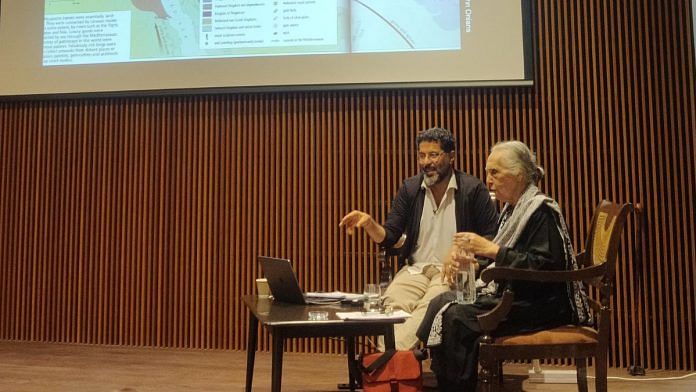New Delhi: Near modern-day Peshawar, in ancient Yusufzai, stands a statue that reshapes our view of the ancient world — Hariti, the Buddhist mother goddess, flanked by Greek, Egyptian, Hindu, and Phoenician figures. In an era often defined by conquest, this 2,000-year-old figure answers modern questions of immigration, integration, and shared identity.
“The children around Hariti include Kartikeya (son of Shiva and Parvati), Priyankera, a Phoenician figure, the Dioscuri twins (Gemini), the Egyptian Harpocrates, and possibly the Zoroastrians Amardad and Hordad. This isn’t just a religious icon but a deliberate act of inclusion. Positioned at the monastery gate, Hariti was a public figure meant to be recognised by all — as each group could see their own mother goddess in her,” said Naman Ahuja, professor of Indian art and architecture at Jawaharlal Nehru University, art historian, and curator.
In their 28 July lecture, titled Beyond Boundaries, at Humayun’s Tomb Museum, Ahuja and Romila Thapar, professor emerita of ancient Indian history at JNU, revealed a rich mosaic of ancient global connections. They showed how art, trade, and beliefs transcended borders, creating dynamic hybrid cultures.
Speaking to an audience of scholars, students, and history enthusiasts, they explored a time when the Indian Ocean wasn’t a divide but a conduit for spices, sculpture, and syncretic belief systems — connecting bustling Indian ports to Roman villas, Greek settlements in Afghanistan, and beyond.
From Greece to India
Ahuja viewed migration as more than just movement — it’s an emotional response to loss, longing, and the complex reasons people leave home. He examined diasporic Greeks in distant cities like Ai Khanoum in Bactria (modern-day Afghanistan). For instance, a sundial there was calibrated not to Afghanistan’s sun but to Egypt’s, highlighting the question: what culture do diasporic communities truly uphold?
This culture existed between memory and adaptation, preserving homeland customs even as the homeland itself changed profoundly. Near Afghanistan’s Jalalabad, at the Buddhist site of Tepe Shotor, a sculpture depicts the Buddha flanked by Hariti and Vajrapani — but Vajrapani appears as Herakles.
“It’s not a statue of Hercules; it’s Vajrapani dressed and acting like Hercules,” Ahuja explained. This blending was a deliberate adaptation, using familiar Greek forms to integrate Greek settlers into Buddhist society. It wasn’t about copying Greek gods but making Buddhism accessible to a diverse, multicultural community.
Also read: Who is the Indian university really for? Delhi scholars critique NEP’s gaps
The black gold
The western coast of India in the early centuries AD was a place alive with foreign tongues, goods from across continents, and a kind of human exchange that textbooks seldom do justice to.
“The pepper tree, which grows abundantly along India’s west coast, travelled over land and sea all the way to Alexandria and then to Rome,” said Thapar. “It was so valuable it attracted many Roman foreigners and is even called black gold in the Sangam texts.”
Thapar emphasised that connections between Greece, Persia, Egypt, and India were deep and ongoing. “The Ashokan edicts found in Tamil Nadu — translated from Prakrit into Greek and Aramaic and inscribed elegantly on stone — reflect this sustained cultural dialogue, not just trade or conquest.”
The shift from outsider to insider was complex and gradual. Yavanas, once labelled mlechchhas, eventually got integrated into Indian society.
“The Jain Prakrit Angavijja groups Yavanas as mlechchha, but by the Manusmriti era (6th or 5th century AD), 61 mixed castes are recognised, including Yavana,” said Ahuja.
These textual changes mirror deeper social shifts as migrants became part of society. This evolution is also seen in personal artefacts — rings, cameos, and ivories.
A carved sardonyx cameo from Bannu (Pakistan) depicting Hercules with a lion-skin cape, dating to the second century AD, signals cultural adoption.
A Satavahana-style ivory Yakshi statuette was found in Pompeii, buried beneath Mount Vesuvius’s ash. “Why would someone want that in their home?” Ahuja said. Meanwhile, in Kolhapur, Indian families acquired Greek bronzes of Perseus and Andromeda.
“Indian families engaged with Roman mythology as Roman families learned about Indian ideas,” he added.
Rome-India trade peaked between 100 BC and 200 AD, during Augustus’s reign, with maximum pepper imports paid in gold and silver.
“While Antony and Cleopatra’s romance captures our imagination, Egypt’s crucial economic role in controlling trade — especially northern Egypt near the Red Sea — is often overlooked,” Thapar said.
Also read: KM Panikkar was a scapegoat. It was easier to blame him for China than Nehru
Spice, silk, and statues
The trade followed seasonal rhythms: the southwest monsoon carried Roman ships from Red Sea ports like Myos Hormos and Berenike to Indian harbors such as Muziris, while the northeast monsoon brought them home months later. During this time, sailors and merchants lived alongside local communities.
“You had about 120 shiploads of traders in Muziris at any given time, loading fresh cargoes of pepper to take back,” said Thapar.
Archaeological finds reinforce this connection. Over 17,000 amphora shards — vessels from southern Italy and the Greek islands used for wine and olive oil — have been uncovered across peninsular India. As archaeologist Naman Ahuja explained, “This was wine coming all the way from the Mediterranean into South India.”
Trade wasn’t one-sided. Indian merchants exported ivory, teak, ebony, indigo, cotton textiles, carnelian gems, and exotic animals like peacocks, monkeys, and elephants.
Yet, as Thapar highlighted, Indian perspectives on these encounters are notably missing. “There isn’t a single Indian account of someone traveling abroad and describing their experiences among unfamiliar peoples. This absence is striking.”
By the third century CE, Indo-Roman trade began to decline, affected by political shifts such as the rise of Byzantium, changing control of Egypt, and India’s growing ties with Southeast Asia. Still, the legacy endures, visible in artefacts spread across museums worldwide.
Temples dedicated to Augustus stood alongside Buddhist viharas in the Western Deccan. “Buddhist monks and monasteries actively invested in trade, profiting from it,” said Thapar. “That’s why some monasteries are so lavishly carved into rock.”
(Edited by Aamaan Alam Khan)






